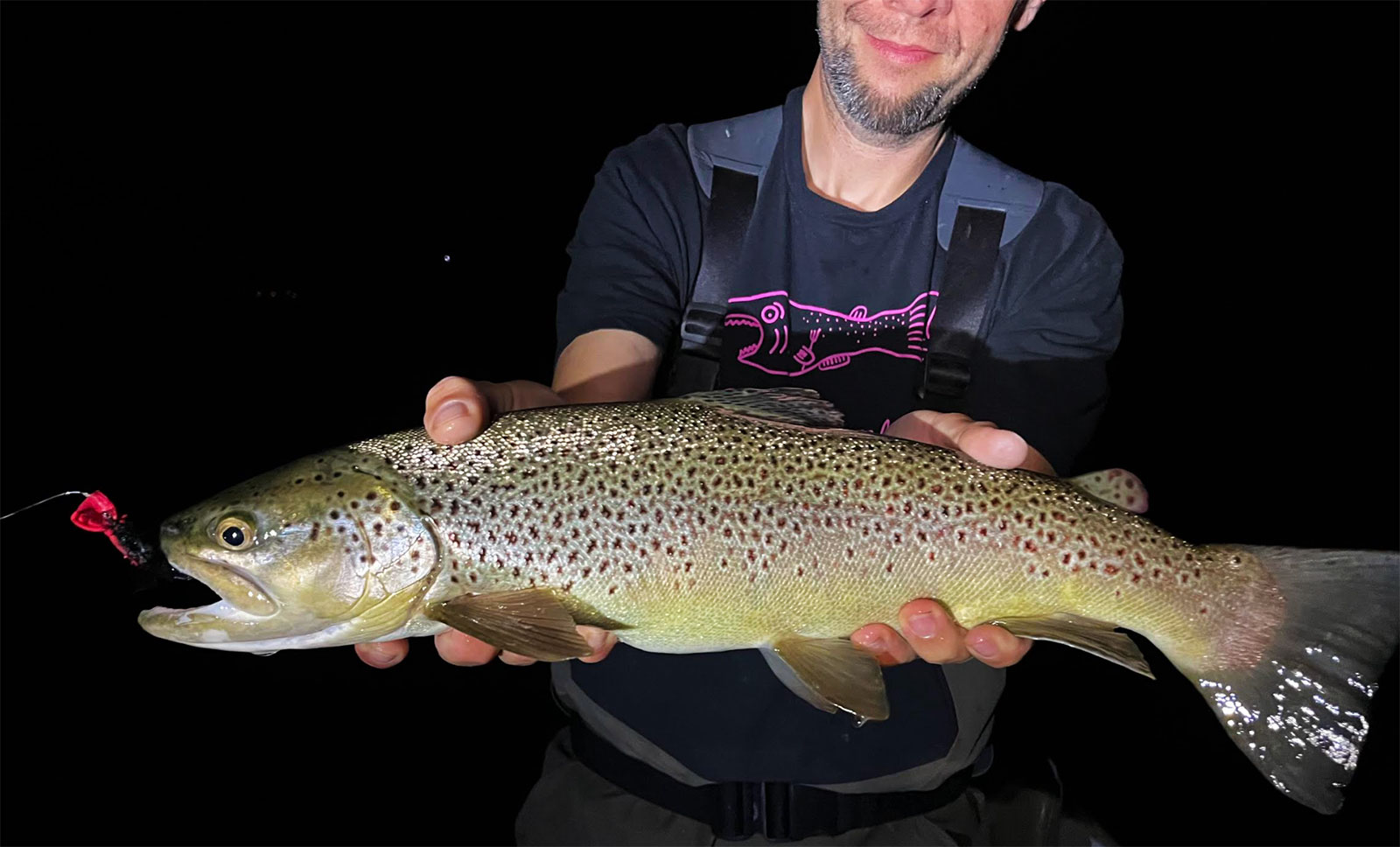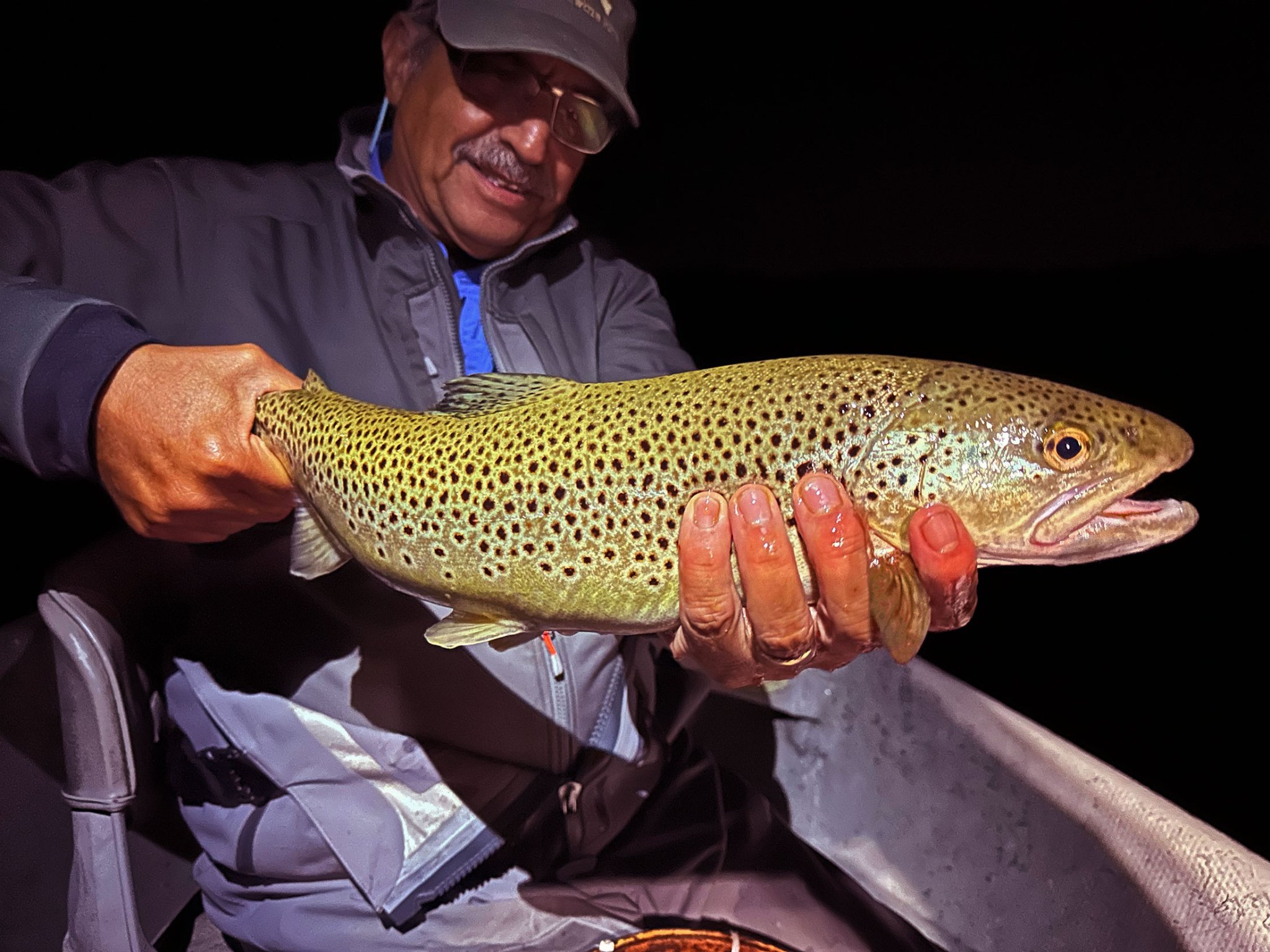Catfish, striped bass, and walleyes are just a few fish widely known to hunt nocturnally. It’s not uncommon for anglers to wait until the sun sets to get after them, especially considering the bigger specimens often fall after dusk. These, of course, are not the only sportfish that hunt while we’re sleeping. Largemouth bass, muskies, and saltwater species like snook and tarpon prowl the darkness, too. What fewer anglers realize, however, is that trout — browns especially — do a lot of their foraging in the dark, particularly in the summer. But fishing your favorite trout stream or river after the lights go out is a bit more challenging than night fishing on still water.
In this episode of the Quick Strike podcast I talk to Joe Demalderis, who is a veteran guide on New York’s Upper Delaware River. We’ve been good friends for nearly 20 years and every summer for the last nine of those years, I’ve driven up to spend a few nights on the river throwing mouse patterns from dusk into the wee hours of the morning. “Mousing” for trout has gotten very trendy in fly fishing circles over the last few years, but the truth is that fly fishing in the dark has been happening practically since the sport was invented. While Demalderis’s outfitter service is one of the few in his area that recently began offering mouse trips, he’s been targeting nighttime trout with a variety of methods for decades before it got popular.
It’s important to understand that this is not a fly-only game; if you target trout with spinning gear, you can play (and win), too. Trout will attack all manner of offerings in the dark, from mouse flies to streamers, jerkbaits to Spooks, Jittergbugs to Pop-Rs. If what you’re casting can be mistaken for a baitfish, tiny toad, Dobson fly, or anything that a big trout might think is a delicious source of protein, you’re in. But before you take a shot at night stalking, consider these key tips.
Fish the “Junk” Water
During the day, trout fishermen gravitate to certain pieces of structure. They cast around boulders that break the current, work seams where fast and slow water meet, shoot for undercut banks, and pick apart riffles and tail-outs. All of these are prime holding areas, but they’re not where you want to be when the sun goes down. That’s because trout behavior and positioning change after dark.
“Brown trout, by nature, are very territorial,” says Demalderis. “They stay in the same places. They have their home. You’ll find a fish in the same spot over and over — until nighttime, that is. When the sun goes down, they feel safer and less exposed, so they’ll go out and cruise around their neighborhood. And they know that if they slide in a shallow back eddy or slower section of the river, that’s where they’re going to find baitfish or a frog or toad on the surface.”
Quite often, the best nighttime spots are those flat, shallow, featureless stretches that fishermen pass right by during daylight. Covering a mile or more of river at night is challenging — if not unsafe at times — so what you want to do is scout out a few likely nighttime hunting areas that you can access easily in the dark, post up in one, and stay put. In this game you’re better off letting the trout come to you than stumbling around hitting smaller areas. Even if the action starts off slow, a fresh fish or two can cruise in at any time during the night.
Read the Bug Life
Don’t assume this tip applies to fly anglers only. Evening bug hatch activity can help you gauge what to cast and how well the fish are going to feed after dark. You might think that seeing loads of trout rising to bugs at dusk would be an indicator of solid night action to come, but according to Demalderis, lots of rising trout can be misleading.
“What I really want to see just before dark is little to no bugs,” he says. “Our best nights throwing mouse flies are often when the hatches are minimal or non-existent, because the trout are waiting for a hatch or a spinner fall, they’re looking up ready to eat, but there’s no food. Then you start presenting a mouse pattern and they’re all over it.”
On nights when trout are fixated and gorging on bugs, casting larger surface targets can actually be much less effective. But if this is the scenario you’re presented with, try switching to a subsurface offering like a large, dark streamer or jerkbait.
Scout Ahead of Time

Knowing a stream like the back of your hand is a huge plus for night fishing, especially if there are boats involved. When I fish with Demalderis, we attack via his drift boat. Even though I own a drift boat as well, I simply don’t spend enough time on the rivers he fishes to feel comfortable rowing in the dark without him on board to guide me. But, even if you’re fishing on foot, the better you know a stretch by day, the more successful you’ll be at night.
“If you fish a certain piece of river or stream, and you fish there once a month, twice a month, or even once a week, you might not know it well enough to fish it safely at night,” Demalderis says. “Everything is different in the dark, and nighttime is definitely the wrong time to go explore a stream you’ve never fished at all.”
Ideally, you’ll know exactly which piece of water or three you plan to hit. Arrive when there’s a little daylight left and be as familiar with trails and accesses as possible. A headlamp is a must because you don’t want to be fumbling with your phone at night on the water. Just remember to avoid shining that light on the surface at any time. If you need to check your lure or fly for debris or change something up, go back to the bank before turning on your light and face your beam away from the water. Bigger, smarter fish often fall at night because they have no idea you’re there, but unnatural light on the water will give you away fast.
Beef Up Your Tackle
Demalderis doesn’t really like targeting trout in water warmer than 68 degrees, as the energy they expend during the fight can be lethal in warm water with low oxygen levels. This is most concerning when targeting wild trout, but at night water temperatures will drop. If your stream is flirting with being unsafely warm by day, a late-night fight can be less taxing on the fish. Furthermore, because trout won’t be line or leader shy after dark, you can shorten the fight time by bulking up your connections.
Read Next: Best Trout Lures
“When you’re fly fishing during the day, you’re usually forced to use light leader and tippet because without it you won’t fool the fish,” Demalderis says. “At night you can get away with much heavier leader. The fights are so short that the trout are often very green in the net. But if you work quickly, that also means that fish is going to swim away much stronger.”

